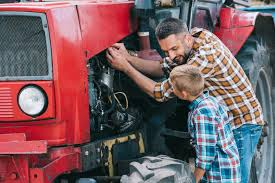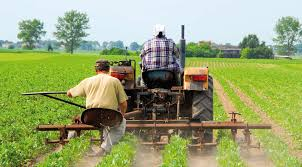Farm maintenance refers to the regular upkeep, repair, and care of a farm’s infrastructure, equipment, livestock, and crop fields. Keeping a farm well-maintained is essential for ensuring smooth operations, minimizing costly repairs, and optimizing productivity. Whether you have a small or large farm, proper maintenance helps to ensure long-term success.
Importance of Regular Farm Maintenance
1. Increases Productivity: Well-maintained equipment, healthy crops, and proper irrigation systems lead to better farm yields.
2. Reduces Costs: Regularly servicing machinery and equipment prevents expensive breakdowns and reduces the need for major repairs.
3. Ensures Safety: Properly maintained livestock facilities, fences, and tools help reduce the risk of accidents and injuries to both animals and farm workers.
4. Prolongs Equipment Lifespan: By maintaining farm tools and machinery, you can extend their operational lifespan, saving money in the long term.
5. Supports Environmental Sustainability: Efficient irrigation systems and careful management of soil and resources help prevent wastage, pollution, and environmental degradation.
Equipment Maintenance and Repair

1. Regular Cleaning: After every use, clean off dirt, mud, and debris from tractors, plows, and other machinery to prevent rust and damage.
2. Lubrication: Regularly oil and grease machinery parts like gears and hinges to keep them functioning smoothly and avoid unnecessary wear.
3. Inspection and Repairs: Periodically inspect equipment for signs of wear, cracks, or loose parts. Repair or replace parts before they cause equipment breakdown.
4. Storage: Store machinery in dry, covered areas to protect them from weather elements like rain and sunlight that can degrade their condition.
5. Follow Manufacturer’s Guidelines: Adhere to the maintenance schedule and guidelines provided by the manufacturer for optimal performance and longer equipment lifespan.
Irrigation System Maintenance
1. Regular Inspection: Check irrigation pipes, sprinklers, and drip systems regularly for blockages, leaks, or damage.
2. Cleaning Filters: Clean the filters of irrigation systems periodically to prevent clogging and ensure smooth water flow.
3. Monitor Water Pressure: Ensure the system is operating at the correct water pressure to avoid damaging crops or wasting water.
4. Winterizing Systems: In colder climates, drain water from irrigation systems before winter to prevent pipes from freezing and bursting.
5. Calibration: Regularly calibrate irrigation systems to provide the proper water distribution needed for each crop.
Livestock Facility Upkeep
1. Cleanliness: Regularly clean livestock stalls, barns, and pens to prevent disease buildup and ensure a healthy environment.
2. Fencing Maintenance: Inspect and repair fences to prevent livestock from escaping and to keep predators out.
3. Ventilation: Ensure proper ventilation in animal housing to prevent respiratory issues and keep air quality healthy.
4. Bedding Replacement: Regularly replace bedding materials like straw or wood shavings to keep livestock comfortable and reduce the spread of bacteria.
5. Water Supply: Ensure that livestock always have access to fresh, clean water, and regularly check water troughs for cleanliness.
Read Also: How to Raise Catfish and Tilapia in the Same Fish Pond at the Same Time
Crop Field Management and Care

1. Soil Testing: Regularly test soil to determine nutrient levels and pH, ensuring that plants have the right conditions for growth.
2. Fertilization: Apply fertilizers based on the results of soil testing, ensuring that crops receive the necessary nutrients.
3. Weed Control: Remove weeds that compete with crops for nutrients, water, and sunlight.
4. Pest Management: Implement integrated pest management (IPM) strategies to control pests and diseases that can damage crops.
5. Crop Rotation: Practice crop rotation to maintain soil health and reduce the build-up of pests and diseases.
Best Practices for Farm Maintenance
1. Create a Maintenance Schedule: Develop a regular maintenance schedule for all farm equipment, irrigation systems, and livestock facilities.
2. Training: Train all farm workers on the proper use, care, and maintenance of equipment and facilities.
3. Budget for Maintenance: Set aside part of the farm’s budget for ongoing maintenance costs to avoid unexpected expenses.
4. Record Keeping: Keep detailed records of maintenance activities, including repairs, replacements, and servicing.
5. Sustainability: Implement sustainable practices such as using organic fertilizers, water conservation techniques, and energy-efficient equipment to reduce the farm’s environmental impact.
Farm Building and Fence Maintenance
1. Regular Inspections: Check buildings and fences regularly for damage or wear, such as rotting wood or rusted metal.
2. Repairs: Promptly repair any issues, such as fixing holes in fences or replacing broken doors and windows.
3. Painting and Sealing: Apply paint or sealants to wooden structures to protect them from moisture and pests.
4. Drainage: Ensure proper drainage around buildings to prevent water accumulation, which can lead to structural damage.
5. Security Measures: Install locks and security systems to protect buildings and equipment from theft.
Soil Health and Fertility Management
1. Soil Testing: Conduct regular soil tests to assess nutrient levels, pH, and organic matter content.
2. Organic Matter Addition: Incorporate organic matter, such as compost or manure, to improve soil structure and fertility.
3. Cover Crops: Use cover crops to enhance soil health, prevent erosion, and fix nitrogen levels.
4. Crop Rotation: Rotate crops to improve soil nutrients and break pest cycles.
5. Reduced Tillage: Minimize tillage to protect soil structure and reduce erosion.
Pest and Disease Prevention Strategies
1. Regular Monitoring: Inspect crops frequently for signs of pests and diseases.
2. Sanitation Practices: Keep fields and facilities clean to reduce the risk of pest infestations.
3. Biological Controls: Use natural predators or beneficial insects to manage pest populations.
4. Resistant Varieties: Plant disease-resistant crop varieties to reduce vulnerability.
5. Integrated Pest Management (IPM): Implement IPM practices to combine multiple control methods for effective pest management.
Read Also: The Best Specie of Fish to Raise for Profit
Seasonal Maintenance Checklist

1. Spring: Inspect irrigation systems, prepare soil, and plant crops.
2. Summer: Monitor crops for pests and diseases, and maintain irrigation.
3. Fall: Harvest crops, clean equipment, and prepare fields for winter.
4. Winter: Inspect and repair buildings and fences, and service machinery.
5. Year-Round: Keep records of maintenance tasks, and adjust practices as needed.
Sustainable Farm Maintenance Practices
1. Resource Conservation: Use water and energy efficiently to minimize waste.
2. Integrated Practices: Combine crop, livestock, and soil management strategies for holistic care.
3. Local Inputs: Source inputs locally to reduce transportation costs and support the local economy.
4. Biodiversity Promotion: Encourage biodiversity by planting a variety of crops and preserving natural habitats.
5. Education and Training: Stay informed about sustainable practices and train staff on their implementation.
Read Also: Banana Tree Care: What You Need to Know
Frequently Asked Questions
We will update this section soon.

